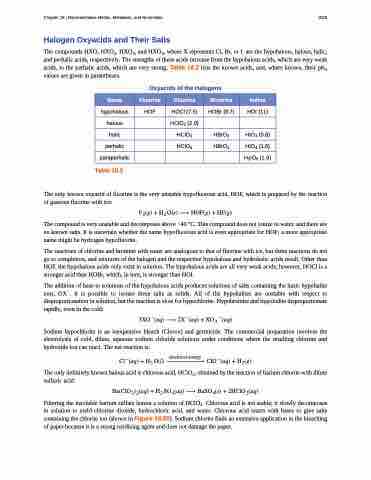Page 1035 - Chemistry--atom first
P. 1035
Chapter 18 | Representative Metals, Metalloids, and Nonmetals 1025
Halogen Oxyacids and Their Salts
The compounds HXO, HXO2, HXO3, and HXO4, where X represents Cl, Br, or I, are the hypohalous, halous, halic, and perhalic acids, respectively. The strengths of these acids increase from the hypohalous acids, which are very weak acids, to the perhalic acids, which are very strong. Table 18.2 lists the known acids, and, where known, their pKa values are given in parentheses.
Oxyacids of the Halogens
Name
Fluorine
Chlorine
Bromine
Iodine
hypohalous
HOF
HOCl (7.5)
HOBr (8.7)
HOI (11)
halous
HClO2 (2.0)
halic
HClO3
HBrO3
HIO3 (0.8)
perhalic
HClO4
HBrO4
HIO4 (1.6)
paraperhalic
H5IO6 (1.6)
Table 18.2
The only known oxyacid of fluorine is the very unstable hypofluorous acid, HOF, which is prepared by the reaction of gaseous fluorine with ice:
����� � �� ���� � ������ � �����
The compound is very unstable and decomposes above −40 °C. This compound does not ionize in water, and there are no known salts. It is uncertain whether the name hypofluorous acid is even appropriate for HOF; a more appropriate name might be hydrogen hypofluorite.
The reactions of chlorine and bromine with water are analogous to that of fluorine with ice, but these reactions do not go to completion, and mixtures of the halogen and the respective hypohalous and hydrohalic acids result. Other than HOF, the hypohalous acids only exist in solution. The hypohalous acids are all very weak acids; however, HOCl is a stronger acid than HOBr, which, in turn, is stronger than HOI.
The addition of base to solutions of the hypohalous acids produces solutions of salts containing the basic hypohalite ions, OX−. It is possible to isolate these salts as solids. All of the hypohalites are unstable with respect to disproportionation in solution, but the reaction is slow for hypochlorite. Hypobromite and hypoiodite disproportionate rapidly, even in the cold:
�������� � ������� � ��� �����
Sodium hypochlorite is an inexpensive bleach (Clorox) and germicide. The commercial preparation involves the electrolysis of cold, dilute, aqueous sodium chloride solutions under conditions where the resulting chlorine and hydroxide ion can react. The net reaction is:
� ���������� ������ �
�� ���� � �� ���� ������������������� ��� ���� � �����
The only definitely known halous acid is chlorous acid, HClO2, obtained by the reaction of barium chlorite with dilute sulfuric acid:
������������� � �� ������� � �������� � ����������
Filtering the insoluble barium sulfate leaves a solution of HClO2. Chlorous acid is not stable; it slowly decomposes in solution to yield chlorine dioxide, hydrochloric acid, and water. Chlorous acid reacts with bases to give salts containing the chlorite ion (shown in Figure 18.55). Sodium chlorite finds an extensive application in the bleaching of paper because it is a strong oxidizing agent and does not damage the paper.


